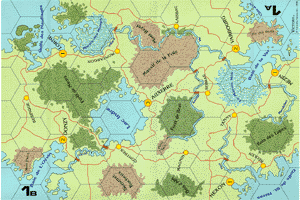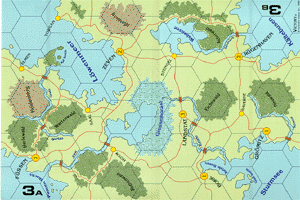

Timothy was using these maps.


We both felt that the games flow was MUCH better using your rule changes. However, we did forget to reduce the stacking in TOWNS, but we intend to do this in th e future. It was suggested that maybe stacking in towns should be 3 (given less clutter to prevent it.)
I think it would be best to stick with two, but see how it plays and let me know . . .
Overall we believe you have come up with a simple way to overcome the stalemate problem in Victory. We are looking forward to testing it with elite units and such. Another great effect was that certain hexs and certain terrain became important, not just cities and the occasional town. We did have one slight problem with your rules about supply. In your rules, the wording seemes to suggest that all you need to do is blockade a port to cut it from supply. This didn't seem right to us, but it might just be a matter of wording. We also took the wording "cut off from the road net" to mean that you must occupy all hexes surrounding the city that connect to friendly roads. For example, you can't cut a city off from supp! ly by holding a road hex two hexes away that happens to cut the city off from all the other cites.
I was thinking that cities with access to sea hexes are supplied from the sea AND the roads, so you have to cut both the roads AND have a blockade in order to cut supply to these cities.
With regard to cutting supply several hexes away, what I understand you to be saying is that if the city is adjacent to a road hex that is still in supply, then supply isn't cut, even if the place where the road actually goes "into" the city is cut off, correct? I guess I wouldn't have a problem with that, but again, it would be interesting to see if other people have any input, etc.
Still these are minor concerns. Overall we are VERY happy with the tweaked rules. I was sorry to see so much resistance to your ideas in the Columbia games forums. It's seems most of the guys there just like to make up lists of units.
Timothy Daly renard@avalon.net
I think that is part of the fun for many people, and I really don't have a problem with it. What I'm trying to address is the fundamental game underneath all the unit capability "chrome." I'm hoping to get a group of players to playtest this and develop enough action around a specific set of simple yet fundamental rule changes so that we can take this to Columbia and get some feedback. I appreciate your willingness to give it a shot!
Thanks again.
In a follow-up message, Timothy writes:
Basically, what (operationally) do you mean by "cut off from the road net?" That part of the rule seems to be unclear to me and the people I play with.
The way I see it, "cut off" means that there are no roads to the city
that can eventually be traced to at least one other friendly city.
Sure, the roads go to towns, etc, but eventually they all go to one
city or another.
If an enemy player controls a hex with a road, then there is an
interrupt in that road, and the supply is cut from that point. Of
course, the enemy player will most likely be out of supply as well
unless he controls a nearby coastal town (where supplies can be
traced via the sea) or happens to be able to trace the supply from
the road net that HE controls, etc.
The way I see this working is that enemy units will make airborne,
amphibious, and/or armored thrusts PAST a city to cut supply, with
the full knowledge that they will be subject to supply attrition (as
well as counterattacks) themselves in subsequent turns. Also, a
determination will have to be made whether to attack when you have
the initiative, ensuring that your opponent will take a number of
supply "hits" but definitely giving him the chance to counterattack
before the production phase, or attack LAST, making the initiative
roll on the following turn all the more crucial, as it determines the
counter attack capability, etc.
Previously, Columbia stated that units had to be in supply in order
to cut supply, and ANY city was able to provide unlimited supply.
This effectively made it impossible to conduct operations as I've
outlined above, as elaborate supply considerations necessarily made
any invasion a HUGE affair, and the cutting of enemy supply a rather
meaningless endeavor. Airborne units could be dropped into attacks,
but given the fact that they counted for BOTH air and land stacking
limits, (plus the fact that the idea of dropping airborne troops into
a city is rather ludicrous) it was a much better idea to substitute
an additional DB, FA, or HB and any additional land unit.
Sure, in the original game they were good for taking a poorly
defended coastal town by surprise, but on the whole, they have poor
firepower and are not very valuable in any kind of assault. This new "tweak" puts them into
the more traditional role that we have seen them perform: cutting
communications, taking key bridges, disrupting the rear, etc.
The
fact that it is nearly certain that they will take a supply hit is
reflective of the fact that given their role, they would certainly
take casualties. You can't drop paratroopers behind enemy lines and
expect that they will all survive, nor can you postulate (as Columbia
seems to) that until the beachhead and/or supply lines are
established, the paratroopers are going to go into hiding and not do
their job.
On 3-25, Timothy wrote again saying:
Of course, this is bound to provoke grumbles about the use of Paratroopers as
defensive units . . .
However, they eventually surrounded a city of mine and took it through a combination of naval bombardment, supply attrition followed by an armored assualt. It was a very exciting game. We have started using the elite counter set. We have found that the Mech Infantry is quite useful in defense.
It sounds great. I'm glad to hear that it seems to be working.
We did have one question that we could not find in the rules. It doesn't relate to your rules tweaks directly, but you seem to have a similar design attitude that we have, so I though I'd see what you think. Given the fact that paratroopers are so useful, we are wondering if you are allowed (or should be allowed) to respond to para-drops into empty hexes (with air or mech)? I'd be interested to hear your thoughts about this.
I would say that you could respond with the mech, but couldn't respond with the air. The
first reason is that the land units would be better equipped to handle something like that - I can't
imagine an air attack being very effective against several thousand paratroopers scattered all over
the place. The second is for game balance. If you allow the mech to respond, the paratroops will
face a tough battle and be lucky to survive. That's limited by the fact that mech can only respond from
one hex and is fine, nothing is supposed to be a free ride.
But if you also allow air to respond, (from TWO hexes away . . . ) the
paratroops will almost surely die.
So perhaps we should compromise and say yes to the mech and no to the air. Remember,
an attacker can try to "pin" any likely response with an air attack on units that may be in range of a
paratroop unit
Again, let me know how this turns out.
Jim
Back to the Victory Page